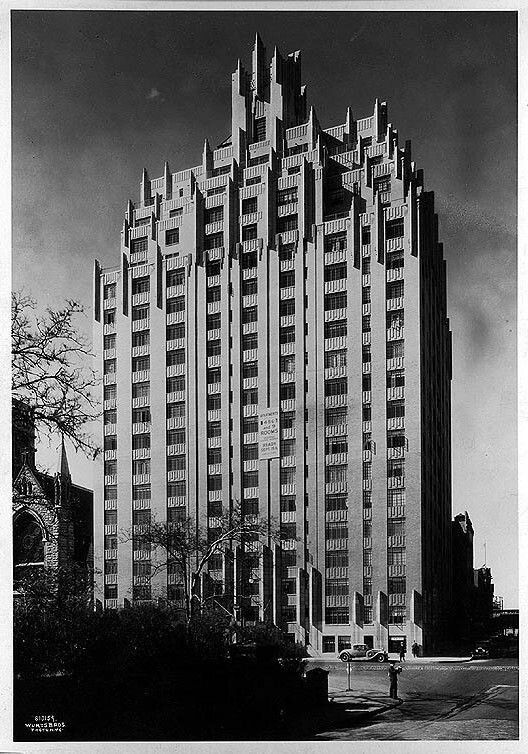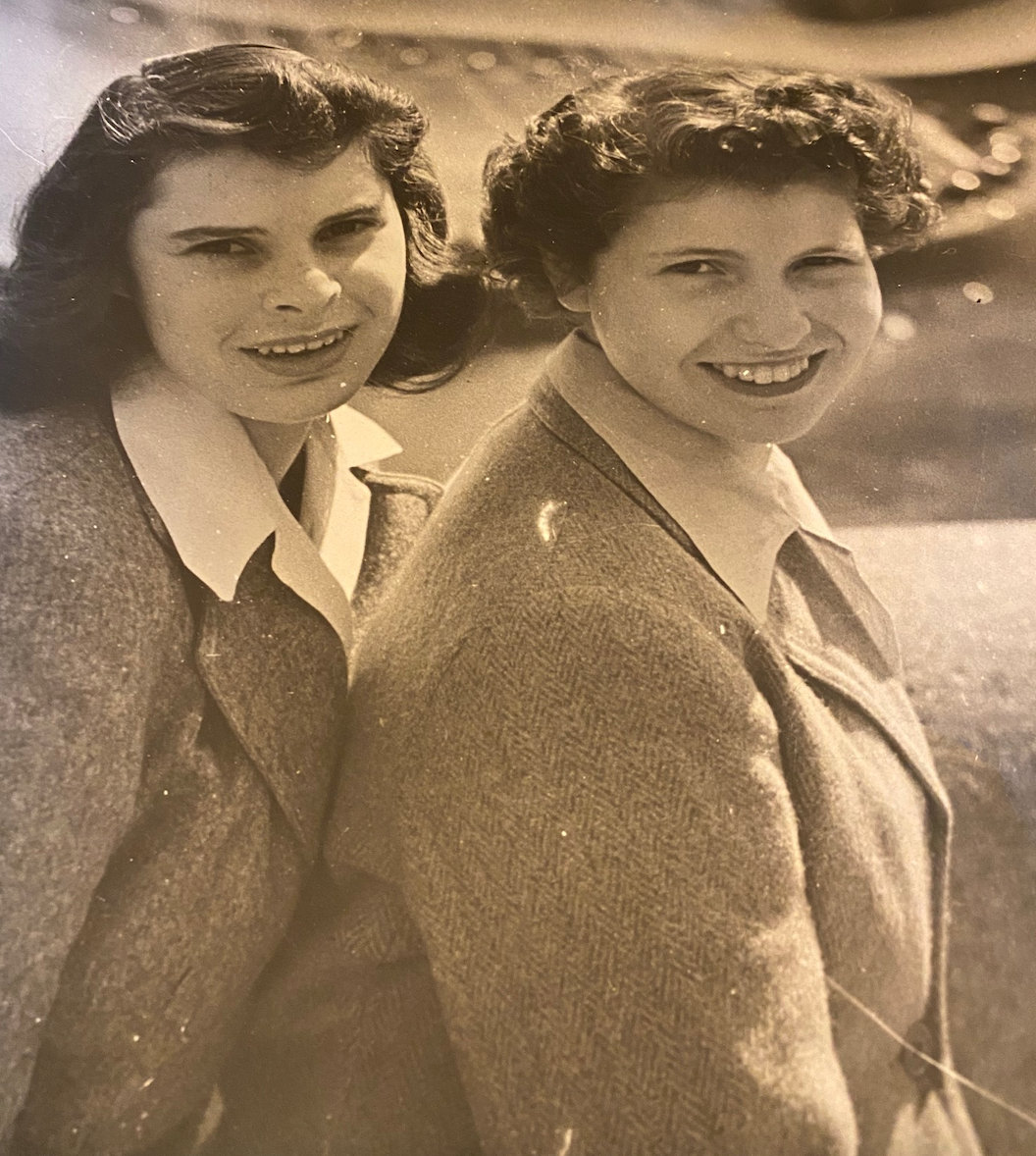My American Story: Pat Schoenfeld
The future “Mrs. Broadway” with Irish and Russian heritage grew up as a true New Yorker.
What is my American Story? How can I answer that question? One must understand: in my story, people weren’t told their family history.
Much of what I know now is what I have figured out from family stories, without much detail. When I grew up, being an American meant you were special. Being an American wasn’t what you were, it was a fact in addition to who you were. If I was ever asked what I was, my answer would be, “I am a New Yorker.” At that time, we would not have even thought to say, “We are American.”
The years of my childhood were the Depression years and the World War II years. Not only did we not travel outside of our area, we only met people who were refugees from WW2-ravaged Europe and no one talked about where they came from. My mother would say, “It is impolite to ask those questions.”
The New York City Victory Parade, celebrating the victorious end of WWII on Fifth Avenue, Jan. 12, 1946
Broadway, 1950
I knew my mother’s grandfather, my great grandfather, came to America from Russia in the 1870’s. He went back there to get his wife, but she was pregnant at the time, so he returned, now with his wife and newborn son, my grandfather Charles Rosenberg, around 1885.
Shops on Amsterdam Avenue, Upper West Side of New York, 1949
Both my parents were born in New York. My mother, Mabel Rosenberg, grew up on the Lower East Side. The family lived there because her father Charles, born in Russia and raised in New York, grew up to become a lawyer and wanted to be able to come home for lunch with my grandmother Fanny. Though, when I knew both my grandparents they lived in gorgeous old apartments on the Upper West Side.
My father, S. Peter Miller, grew up in a mansion in Brooklyn. His father, my grandfather Harry, was in the real estate business and owned major properties in Manhattan: all of this was lost in the Depression.
New York schoolgirls relax, 1953
Though I knew my grandfather very well, I know almost nothing of his personal history, except that my family said he came over from Ireland, and was a very non-practicing Jew. All I knew of my father’s family background, and what was important to me, was that my father’s mother, my grandmother Sara, made wonderful French Toast. You could smell it when you got off the elevator in their apartment. She was the story book grandma: baking cookies and sending them to me in college, buying me the hair ribbons my mother didn’t love in my hair, and being there to give me lunch when, in Jr. High, I fell in love with a boy that lived in their building.
I was born in 1929 on the Upper West Side of Manhattan, New York. Franklin Delano Roosevelt was in the White House for almost all of my young memory. He was our father; our king; our leader. And, like Trump supporters believe in my world today, back then if you didn’t support FDR, you were un-American and not part of my young world.
A new apartment building on Central Park West, built 1930
What was important to me growing up at this time was that my family was different, because I was second generation: my family were all Americans. My friends’ families all came over later than mine, and my friends were all first generation immigrants. They and their families had come to America to seek their fortunes in the mid 1920’s and 1930’s. They were all in the garment trades or real estate. They all lived in big apartments on West End Avenue or Central Park West. They were richer than we were. We lived in a small building in a 2 bedroom apartment on West 78th Street off Riverside Drive.
Horseback riding in Central Park, 1940’s
My friends and I all went to private schools. We were the first generation to go to private schools not because we were rich, but because our parents were concerned about our education. The public schools were changing. Class sizes were getting bigger and our parents didn’t think we were getting the attention we needed in the public schools.
This was the beginning of my understanding that, as established New Yorkers, my family was different. My parents had an American attitude, they were open and welcoming to all my friends. My friends’ parents had a European point of view, they brought up their children in a much more reserved and regulated way, and they were much less open to me and our other friends.
And my parents’ attitude was different because they both were born and brought up in New York; they worked hard and gave my sister Cynthia and me a knowledge that we could do or be anything we wanted. How rare it was that my father took a major interest in our development! He took us out every Sunday to tour Manhattan, go horseback riding in Central park and play tennis.
I graduated from high school in 1946. I told my parents I had to get away from the homogeneous world I grew up in. I didn’t want to go to Vassar, Wellesley, or Smith, places where all the girls I knew were going. Somehow my school advisor suggested that I go to Ohio Wesleyan University.
I was 17 years old, and had never even left the East Coast, and my father put me in an airplane, alone, to Cleveland. From there I took a bus to Delaware, Ohio. I can’t believe that this teenager had the guts to enjoy and embrace that experience. I lasted for 2 years, years that taught me so much. I was not pledged to a sorority because I was a Jew. I recall visiting my best friend, who lived an hour away from school, and her family had no indoor plumbing.
Two students on the NYU campus, 1940
Years later, when my daughter wanted to go off somewhere with her boyfriend, and I did not let her go, I told my mother that I had no idea how she managed to let me go so far from home at such a young age. She told me,“Patsy darling, I taught you everything I knew until you were 12, and then I trusted you.”
Eventually, I met and married the man whom I spent the rest of my life with -- Jerry Schoenfeld, who was first a lawyer and then became one of the most influential figures in American theatre, renowned for his contributions to Broadway through his leadership at the Shubert Organization.
Jerry lived just one block away from me! I knew him from the neighborhood. He had just returned from the University of Illinois after having served in World War II. Jerry was five years older than me, so I had none of the experiences that he had at that time. He was at NYU Law School and I, having returned from Ohio, was then an undergraduate at NYU School of Education.
I would see Jerry in the subway and would join him in our journey to school. We became ‘friends’, but not ‘sweethearts’. It was so rare to have a real ‘boyfriend’. We didn’t even date - until I invited him for dinner. It was during an intersession (now called a January-term) and his parents were in Florida. When I invited him, he told me, “I don’t go to girls’ houses for dinner.”
“I always have friends for dinner,” I said.
That started a long and wonderful romance. We were finally able to marry after Jerry finished Law School - he graduated 2nd in his class, Cum Laude. At the time, none of the big Law Firms would be open to him. They didn’t take Jews. He got a job in a very small firm: they were only 3 old men, one law clerk, a senior partner, a young law clerk, and Jerry. This firm represented the Shuberts. And the rest is history.
Jerry, right, with Bernard Jacobs of the Shubert Organization, left, and Jerome Robbins, director and choreographer
Jerry, left, with Bernard Jacobs, center, and Philip Smith, then CEO of The Shubert Organization, 1970
Jerry’s father Sam came from Vienna, although I think it was by way of Poland. I’m sure that’s where they picked up the name of “Schoenfeld”. His mother was born in New York and her family were not so pleased when she wanted to marry Sam: he was not born in New York so he was not “worthy”.
How sad it is that we were not told the stories of how our relatives came to America and their quest for freedom!
No one would talk about this. I remember I had a wonderful French friend whose family was pursued by the Nazis. She and her sister had an amazing story to tell about their rescue and how they came to America, but she would never fill in details or ever talk about her history. It was only very late in her life that she felt able to tell the story to her children.
Now there are many TV programs and websites that are encouraging people to investigate their family histories, but I have never done that. My daughter Carrie; her husband and children and grandson, my nieces and nephews are my very small but very close family.
My history is a one of a Native New Yorker, and therefore a very proud AMERICAN.
About the author:
Patricia Schoenfeld was born and raised in New York City and has had a long and varied career in the visual and performing arts. After earning her degrees in Child Development, she began teaching at schools on the Lower East Side, before becoming one of the first Guidance Counselors in New York Elementary Schools. She later taught at Hunter College, and worked on an early educational TV program in the late 1950’s.
As an accomplished ceramic artist, her work has been included in many private collections and exhibited in galleries throughout Connecticut and New York. In 1974, she began working with Cornell Capa to establish the International Center of Photography. As a founding staff member of ICP, she launched the book store and the publications department, began the membership and intern programs, and assisted with public relations and corporate memberships. Upon her retirement in 1987 she joined the ICP Board of Trustees where she and other Board members helped cultivate ICP into the organization it is today.















